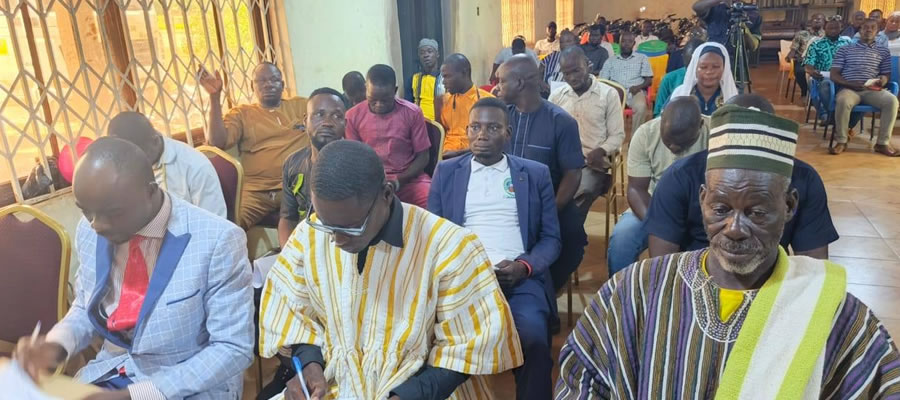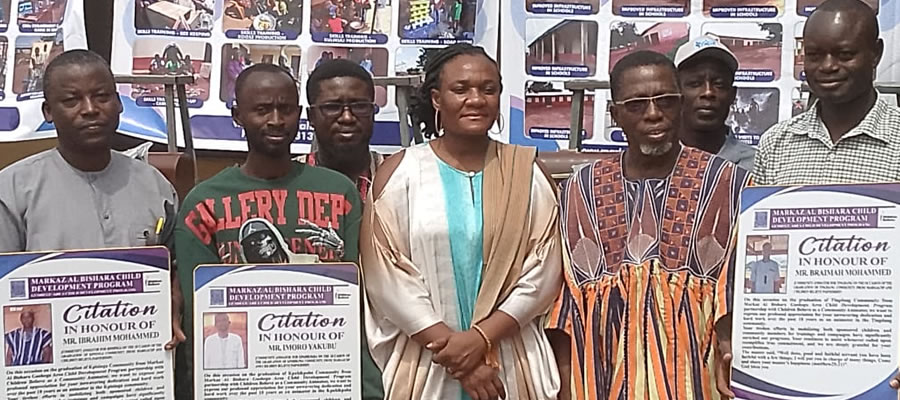

Farming Systems
Farming
Besides crop production, the average farm family raises a wide variety of livestock and poultry. With regards to crop production, semi-permanent to shifting cultivation is practiced in the remote areas of the Municipality where land availability is not a constraint and population density is low.
Mixed cropping dominates the cropping pattern. Sole cropping activities in the Municipality are relatively large commercial rice and maize farms. Commercial rice farming is located in the valley basins of the tributaries of the Black Volta, White Volta and Oti rivers.
Most farming practices involve the traditional labour-intensive type characterized by the use of the hoe and cutlass. However, the initial cultivation of the land (plugging) is highly dependent on mechanization. There are 83 tractors and 402 bullock services available to farmers. Approximately 80% of farmers use tractors in Karaga zone and 40% use tractors in the Gushegu zone. The rest of the farming population in these zones uses animal traction.
To a greater extent, agriculture in the Municipality is predominantly small holder, subsistence and rain-fed. Although the annual rainfall ranges between 950-1300 (sufficient), the erratic nature of the pattern does not augur well for good yields.
Major traditional crops cultivated in the Municipality include maize, sorghum, millet, groundnuts, cowpeas, cassava, rice and yam. Over the years, the land area under cultivation has varied among the crops. While the land under cultivation of many crops has increased, the cultivation of rice has rather declined in the last two years to almost half of the 1996 size. Reasons for the low land cultivation could be attributed to low prices of local rice as a result of the importation of cheap rice. Other reasons are the low levels of input use due to high input/output price ratios. Other causes include inadequate and expensive mechanization services and inappropriate farming practices.
Indeed while land cultivation has increased in all except rice, production levels (yields) have not been commensurate with the increase in land size cultivated. Almost all crops have shown marked production decline over the period except groundnuts, a nitrogen-fixing crop that has shown a fair production increase within the period. This perhaps points to declining soil fertility in the Municipality.
The declining soil fertility, high cost of fertilizer and inappropriate farming practices may have also resulted in low production. None of the crops except yams exceeded the target set in the last Medium Term Development Plan. The Municipality has no land under irrigation. The extension-farmer ratio in the Municipality is 1:3,045. With depleting soil fertility, high cost of agricultural input, poor prices for traditional crop and dependence on rain-fed agriculture, a complementary agricultural practice needs to be incorporated into the Municipal agricultural economy.
The President Special Initiative (PSI) on Agri-business, an initiative to support and strengthened the linkage between agricultural and industry has been launched. Specific attention will be given to the non-traditional crop sub-sector to create wealth.
The importance of non-traditional crops in job and wealth creation is gaining impetus. The non-traditional crop sector in the country has grown very rapidly. In the Gushegu Municipality, the non-traditional crops that and can be promoted include sheanuts, cotton, soybean and cashew. There is need for a more focused strategy to promote non-traditional crops in the Municipality especially among the local private sector players. One however needs to be cautious in the promotion of the non-traditional agriculture as it may be practiced at the expense of food crop cultivation.
Livestock and Poultry Production
Animals reared in the Municipality include cattle, sheep, goats, pigs, local fowls and guinea fowls. In majority of cases, cattle belong to an ethnic group of farmers or family or even a whole village. Traditionally, most farmers in Northern Ghana rear cattle for socio-religious reasons or to serve in ritual events. Two factors of tradition and customs are of great importance to cattle rearing in the region: the prestige of the herd and its value as a self-sustaining investment.
The situation is quite different for small ruminants and rural poultry, where the rearing of these animals is seen as an economic venture and tends towards ownership by individuals. Small ruminants and poultry may be used as security in cases where inadequate rainfall may fail the subsistence farmer. They may also be sold for the purchase of seed and fertilizer during the cropping season and also used in the performance of traditional and religious ceremonies. Above all, in most rural families, small ruminants and rural poultry are most likely to be slaughtered and used in the diet as a source of protein than cattle.
Livestock and poultry are bred under conditions, which are both extensive and traditional. Animal production under traditional management accounts for about 99% of the total livestock population. There are two private Nucleus Sheep Farms in the Municipality. These were established two years ago with the assistance of the Smallholder Agricultural Development Project (SADEP) which supplied improved breeds of Djallonke sheep to farmers.
Veterinary services exist in the Municipality. Apart from vaccinating animals for health reasons, animals, which are to be slaughtered for human consumption, are inspected before they are sold to the public. In spite of the availability of the services to farmers, the percentage of vaccinated animals in the Municipality is abysmally low.
Marketing
The main market centre in the Municipality is Gushegu, They attract traders from far and near including Tamale, Yendi and Bolga. A variety of goods are sold and bought in these markets including industrial and imported goods like clothing, utensil, bicycles, motor bike parts etc. The Municipality's markets are importance centres for agricultural produce such as groundnuts, maize, yams and beans. Gushegu market is very strategic in terms of livestock particularly, cattle.
Livestock
Marketing of livestock in general is not well organized, except in Gushegu where there are livestock markets. But these markets are not very well developed. There are virtually no co-operative societies or livestock associations involved in the marketing of animals. The marketing of livestock is normally done on well-defined routes i.e. from farmer-dealer-middleman-butcher.
Most farmers sell their stock to either butchers or middlemen who convey the animals to towns and cities to sell them to the abattoirs. The majority of animal owners take their animals, either by road or in trucks to the local markets for sale. In some cases, dealers go to the villages to buy these animals. In cases of old or weak animals, they are slaughtered in the village and the meat sold at relatively low prices. In spite of the importance of markets in the Municipality, the structures are not well developed. Indeed, it is only the market in Gushegu that has proper stalls and sheds.
Poverty in the Gushegu Municipality
As indicated earlier, the level of poverty in the country has declined over the last ten years. The Ghana Livings Standards Survey (GLSS) for 1998/99 has shown that overall poverty in the country has declined from 53.7% to 39.5% while extreme poverty has reduced from 36.5% to 26.8%. In terms of socio-economic classification of the poor, food crop farmers are the worse hit accounting for 40% of the poor. There is also a gender as well as spatial/geographical dimension to the poverty profile of the country. With women farmers dominating the food crop cultivation it is certain that they will be the hardest hit.
While however poverty has reduced within the last ten-year period in the country, the incidence of poverty and indeed extreme poverty has rather increased in the Northern Region. Currently, for every ten people in the Northern Region, seven of them are considered as poor. Given that majority of the poor are food crop farmers and given that majority (85%) of the population in the North are food crop farmers, it is almost a definition to say that poverty permeates the heart of every rural household of Northern Region.
As a rural agri-municipality, the incidence of poverty in the Municipality is not better than the picture painted for the Northern Region. A recent World Vision International (WVI) survey indicates that more than two-thirds of households in the region run out of food during some parts of the year. Generally most people in the Municipality run out of food for between 2 – 5 months.
Considering the fact that the Municipality is male dominated, the gender dimension of poverty cannot be ignored. With lack of access to the factors of productive capital, women continue to share a disproportionately high burden of rural poverty. With increasing food insecurity, most women in the Municipality have taken on to several micro and small-scale economic activities in addition to farming to supplement their incomes. The following agricultural-related gender issues have shown detrimental effects on the living standards of women and their families in the Municipality.
• Limited access to, control and ownership of land
• Limited access to credit and financial resources
• Heavy time and responsibility burdens
• High illiteracy rates
• Gender bias in agricultural service delivery
• Household food insecurity
Most small scale farmers sell their produce irrespective of whether their yearly production is adequate to feed the family or not. They sell in poor local commodity markets, and then buy food at higher prices at other times of the year. Generally, agricultural commodity prices fluctuate between the seasons in response to supply and demand. Prices are cheaper at harvest time due to local glut of commodities, poor distribution network and poor market information. However, prices are lowest at harvest time mainly because most farmers are forced to sell their produce due to urgent need for cash to meet loan (used for farming) obligations and social commitments.
On the general agricultural commodity market, including the sale of livestock and poultry, the farmer is a price taker – having no influence over the levels and movement of his commodity prices because of his weak position in the market relative to buyers. Buyers/traders are able to exert a stronger influence on the market because they are generally better organized than farmers are, and better informed about the market. The farming system prevailing is mixed.
Date Created : 11/18/2017 5:09:57 AM









 facebook
facebook
 twitter
twitter
 Youtube
Youtube
 +233 593 831 280
+233 593 831 280 0800 430 430
0800 430 430 GPS: GE-231-4383
GPS: GE-231-4383 info@ghanadistricts.com
info@ghanadistricts.com Box GP1044, Accra, Ghana
Box GP1044, Accra, Ghana